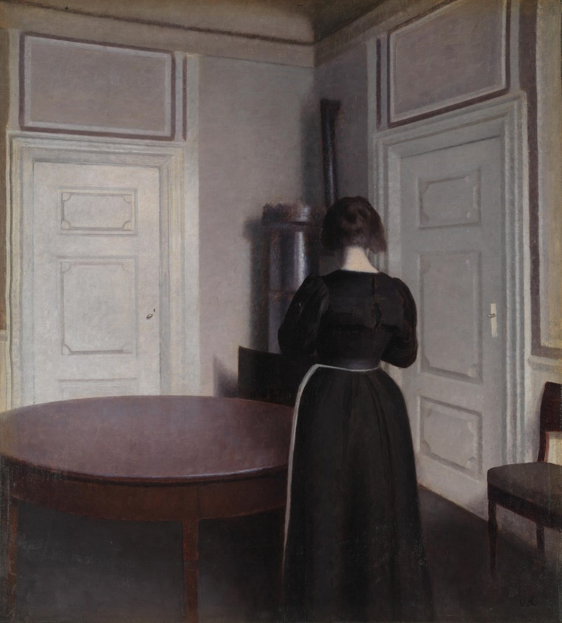|
Sunday 8th March
Upon my bed, night after night I looked for the one whom I love with all my heart. I looked for him but couldn’t find him. “I will rise now and go all around the city, through the streets and the squares. I will look for the one whom I love with all my heart.” I looked for him but couldn’t find him. The guards found me, those who make their rounds in the city. “The one whom I love with all my heart—have you seen him?” No sooner did I depart from them than I found the one whom I love with all my heart. I held on to him and now I won’t let him go, until I’ve brought him to my mother’s house, to the chamber of the one who conceived me. I place you under oath, daughters of Jerusalem, by the gazelles or the wild deer: don’t rouse, don’t arouse love until it desires. Song of Songs 3:1-5 (Common English Bible) Yvonne O’Neal, Vestry Warden, Advocate, U.N. & Anglican Communion Work, Holy Trinity Monday 9th March Vilhelm Hammershoi is a Danish Painter known for paintings of his house. This particular painting is of a room with a large table. Originally the table was larger. When looking closely you can still see the pencil drawing underneath the paint layer. The woman in the painting was added later. She is his wife. In his other paintings she is often depicted reading a book or a letter. The feeling one gets while looking at this painting is kind of a gloomy one. The room has no decorations. The woman is wearing a long black dress, which raises the question: Is she in mourning or is this a woman who is feeling lonely or depressed. The figure has her back turned to us. Destiny De Keyser, St Stephen’s Junior Church Tuesday 10th March We see a woman shut in by closed doors and turned away from us. How can we know her or she us? Do the doors imprison her, or did she choose to be alone with God? For what might she pray? Is God with her in her solitude giving her courage to transform herself and her world? Patsy Weille, HTNC Volunteer & Board Member, Holy Trinity Wednesday 11th March I feel drawn in by the stillness and the quietness. I enjoy the combination of restfulness with the energy of strong clarity. There is softness in the light on the table surface, and the black dress. There is sharpness in the lines around the front table edge, around the apron edge. Perhaps especially in Lent this sense of stillness could be an invitation to slow down. On the other hand the two doors could represent a dramatic choice which is facing this person. We, the person who might pray, are standing behind the figure, perhaps standing with her. The figure could be ourselves or it could be another person who needs our prayer. There may not be anything we can offer other than prayer. Part of us may hope that our prayer will ‘help’ her; part of us sees prayer as an additional way of ‘being with’ another person. Entering the still presence of the image may be a way to do that. Annie Power Member of St Stephen’s Choir and Coordinator of our “Enquirers Group” |
Thursday 12th March
For [Christ] says: Pray interly [interiorly, inwardly, entirely, wholeheartedly] though it seems to you that this has no savour for you; still it is profitable enough, though you may not feel that. Pray wholeheartedly, though you may feel nothing, though you may see nothing, yes, though you think that you could not, for in dryness and barrenness, in sickness and in weakness, then is your prayer most pleasing to me, though you think it almost tasteless to you. Julian of Norwich, Showings of Divine Love, chapter 44. Julian was a fourteenth century English anchorite and author of what is believed to be the earliest surviving book in the English language to be written by a woman. Friday 13th March The room and its occupant are painted in the same subdued tones, so that personality is almost erased, which is emphasised by the rear view that Hammershoi offers us. It is unsettling to see the model as just one of the tastefuliy placed ‘objects’ in the room. At another level, to me the scene radiates quietness, but not loneliness. The lady has space and time to be mindful – distractions are few. Old-master paintings of the Annunciation often place Mary alone in an uncluttered space, calm and attentive to her unique experience. John Turpin, Member of St Stephen’s Church Choir Saturday 14th March It is interesting that this, more than any other painting we have selected, generated the most interest amongst the congregation at St Stephen’s. The theme for this week is “prayer”, something we all should take seriously in our Lenten observance. And Vilhelm Hammershøi’s “Interior” creates a perfect imagine for us to contemplate as we attempt to communicate more deeply with God. I was interested in this painting because Hammershøi was born in 1864 in Copenhagen, Denmark, a city I visited last summer whilst on sabbatical. His pictures I managed to see certainly resembled his poetic, subdued portraits and interiors he was renowned for. And “Interior” is of no exception. What is the young woman in black doing as she faces away from the artist to what seems to be a stove. Is she praying? Using prayer beads? Has the artist stumbled over her by accident...? Is she contemplating something other than the subdued bare room? Do take time to look at this picture in close details, and see for yourself the wonders that Hammershøi creates with his brush to masterful effect. Graham Buckle, Vicar of St Stephen’s Church |
Location |
|

